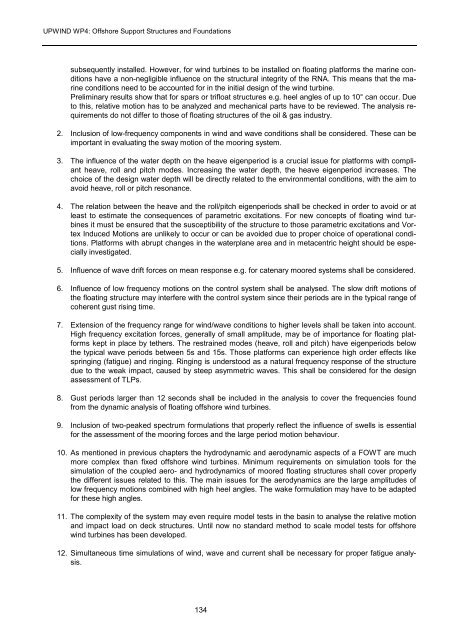Final report for WP4.3: Enhancement of design methods ... - Upwind
Final report for WP4.3: Enhancement of design methods ... - Upwind
Final report for WP4.3: Enhancement of design methods ... - Upwind
Create successful ePaper yourself
Turn your PDF publications into a flip-book with our unique Google optimized e-Paper software.
UPWIND WP4: Offshore Support Structures and Foundations<br />
subsequently installed. However, <strong>for</strong> wind turbines to be installed on floating plat<strong>for</strong>ms the marine conditions<br />
have a non-negligible influence on the structural integrity <strong>of</strong> the RNA. This means that the marine<br />
conditions need to be accounted <strong>for</strong> in the initial <strong>design</strong> <strong>of</strong> the wind turbine.<br />
Preliminary results show that <strong>for</strong> spars or trifloat structures e.g. heel angles <strong>of</strong> up to 10° can occur. Due<br />
to this, relative motion has to be analyzed and mechanical parts have to be reviewed. The analysis requirements<br />
do not differ to those <strong>of</strong> floating structures <strong>of</strong> the oil & gas industry.<br />
2. Inclusion <strong>of</strong> low-frequency components in wind and wave conditions shall be considered. These can be<br />
important in evaluating the sway motion <strong>of</strong> the mooring system.<br />
3. The influence <strong>of</strong> the water depth on the heave eigenperiod is a crucial issue <strong>for</strong> plat<strong>for</strong>ms with compliant<br />
heave, roll and pitch modes. Increasing the water depth, the heave eigenperiod increases. The<br />
choice <strong>of</strong> the <strong>design</strong> water depth will be directly related to the environmental conditions, with the aim to<br />
avoid heave, roll or pitch resonance.<br />
4. The relation between the heave and the roll/pitch eigenperiods shall be checked in order to avoid or at<br />
least to estimate the consequences <strong>of</strong> parametric excitations. For new concepts <strong>of</strong> floating wind turbines<br />
it must be ensured that the susceptibility <strong>of</strong> the structure to those parametric excitations and Vortex<br />
Induced Motions are unlikely to occur or can be avoided due to proper choice <strong>of</strong> operational conditions.<br />
Plat<strong>for</strong>ms with abrupt changes in the waterplane area and in metacentric height should be especially<br />
investigated.<br />
5. Influence <strong>of</strong> wave drift <strong>for</strong>ces on mean response e.g. <strong>for</strong> catenary moored systems shall be considered.<br />
6. Influence <strong>of</strong> low frequency motions on the control system shall be analysed. The slow drift motions <strong>of</strong><br />
the floating structure may interfere with the control system since their periods are in the typical range <strong>of</strong><br />
coherent gust rising time.<br />
7. Extension <strong>of</strong> the frequency range <strong>for</strong> wind/wave conditions to higher levels shall be taken into account.<br />
High frequency excitation <strong>for</strong>ces, generally <strong>of</strong> small amplitude, may be <strong>of</strong> importance <strong>for</strong> floating plat<strong>for</strong>ms<br />
kept in place by tethers. The restrained modes (heave, roll and pitch) have eigenperiods below<br />
the typical wave periods between 5s and 15s. Those plat<strong>for</strong>ms can experience high order effects like<br />
springing (fatigue) and ringing. Ringing is understood as a natural frequency response <strong>of</strong> the structure<br />
due to the weak impact, caused by steep asymmetric waves. This shall be considered <strong>for</strong> the <strong>design</strong><br />
assessment <strong>of</strong> TLPs.<br />
8. Gust periods larger than 12 seconds shall be included in the analysis to cover the frequencies found<br />
from the dynamic analysis <strong>of</strong> floating <strong>of</strong>fshore wind turbines.<br />
9. Inclusion <strong>of</strong> two-peaked spectrum <strong>for</strong>mulations that properly reflect the influence <strong>of</strong> swells is essential<br />
<strong>for</strong> the assessment <strong>of</strong> the mooring <strong>for</strong>ces and the large period motion behaviour.<br />
10. As mentioned in previous chapters the hydrodynamic and aerodynamic aspects <strong>of</strong> a FOWT are much<br />
more complex than fixed <strong>of</strong>fshore wind turbines. Minimum requirements on simulation tools <strong>for</strong> the<br />
simulation <strong>of</strong> the coupled aero- and hydrodynamics <strong>of</strong> moored floating structures shall cover properly<br />
the different issues related to this. The main issues <strong>for</strong> the aerodynamics are the large amplitudes <strong>of</strong><br />
low frequency motions combined with high heel angles. The wake <strong>for</strong>mulation may have to be adapted<br />
<strong>for</strong> these high angles.<br />
11. The complexity <strong>of</strong> the system may even require model tests in the basin to analyse the relative motion<br />
and impact load on deck structures. Until now no standard method to scale model tests <strong>for</strong> <strong>of</strong>fshore<br />
wind turbines has been developed.<br />
12. Simultaneous time simulations <strong>of</strong> wind, wave and current shall be necessary <strong>for</strong> proper fatigue analysis.<br />
134











